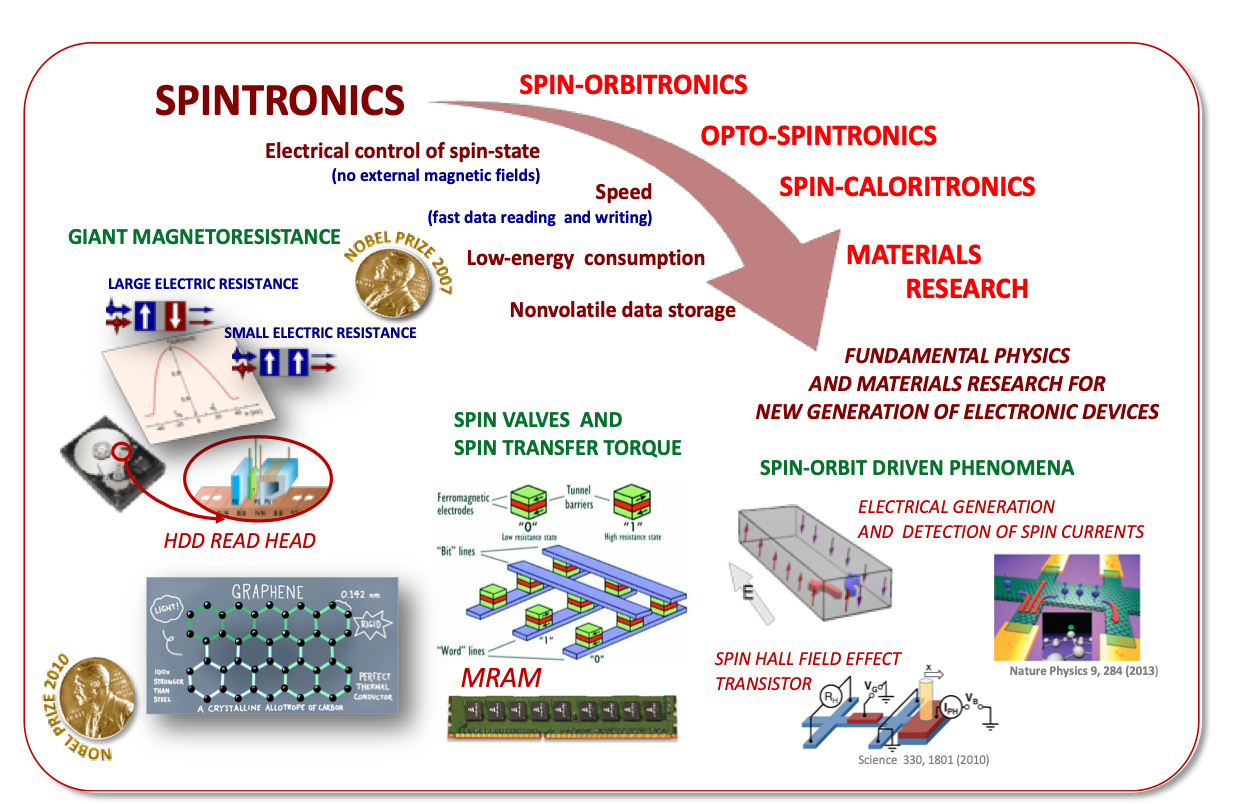
Spintronics, a.k.a. spin electronics or magnetoelectronics, is an area of physics studying role of intrinsic spin degrees of freedom in electronic transport in solid-state devices, molecules, or single atoms. Spintronics have become an important part of science from both its fundamental as well as application point of view since it has a strong potential for emerging technologies. The research in spintronics have brought a number of novel and promissing concepts of advanced electronic devices steered by electric current and/or field with low energy consumption, nonvolatile magnetic memories with ultrafast response, and innovative ways of generating spin currents and spin manipulation.
Spin-Orbit Driven Phenomena
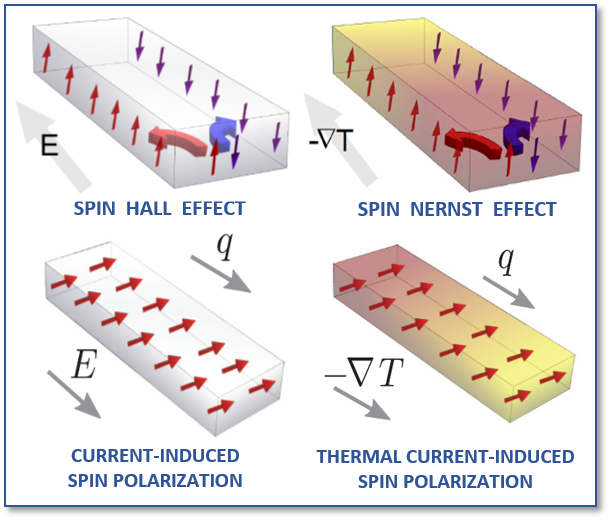
The so-called spin-orbitronics focuses on the phenomena induced by spin-orbit coupling. This coupling leads to a variety of interesting spin and transport phenomena starting with anisotropic magnetoresistance, anomalous and spin Hall effects and ending with non-equilibrium spin polarization and spin-orbit torques.
The spin Hall effect (SHE) is one of the most spectacular example of spin-orbit driven phenomena. SHE gives possibility to create a pure spin currents in nonmagnetic systems without the need to apply external magnetic fields ! This makes it an effective tool for controlling the spin degree of freedom. Nowadays SHE has become not only a standard tool for creation and detection of spin currents and spin polarization but also for generation of spin-torque and magnetization dynamics.
Another interesting consequence of spin-orbit interaction in the systems under external electric field or temperature gradient is non-equilibrium spin polarization (known also as inverse spin-galvanic effect or Edelstein effect). The current-induced spin polarization may be especially important in magnetic materials. In such case the current-induced spin polarization is exchange coupled to the local (equilibrium) magnetization and thus exerts a torque on it. This so called spin-orbit torque (SOT) , in turn, may lead to reorientation of a magnetic moment. SOT may modify or induce magnetic dynamics as well. It should be noted that spin-orbit torque appears also in single layer with uniform magnetization and needs lower current density to switch orientation of magnetization in the system than spin-transfer torque. Therefore spin-orbit torque may be alternative to the widely used spin-transfer torque.
In our group we investigate theoretically spin-orbit driven phenomena using analytical methods of quantum field theory: equilibrium and non-equilibrium Green function formalism at zero and nonzero temperatures. Our analysis are focused on materials that may play a crucial role in further development of spintronics: semiconductor heterostructures , graphene and graphene-like two-dimensional crystals.
Single Molecular Magnets and Adatoms
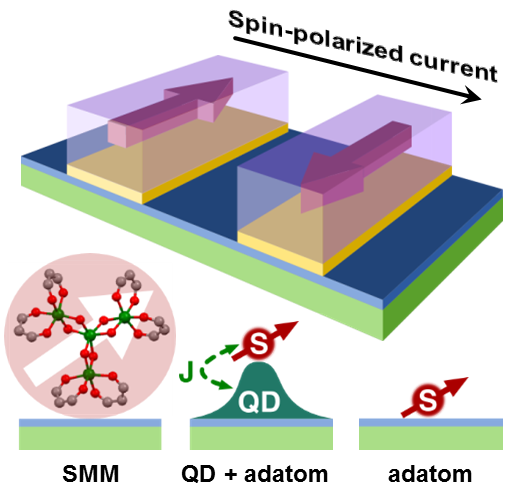
Incorporation of single atoms or molecules into nanoelectronic devices is a very promising challenge, especially from the point of view of information storage and processing technologies. In this context, very prospective seem to be magnetic atoms (like Fe, Co, or Mn) and single-molecule magnets (SMMs) with a large spin S>1/2. Under certain conditions, when attached to an electrode such individual atoms/molecules can acquire (atoms) or retain (SMM) its intrinsic magnetic anisotropy, the property underlying the magnetic bistability. As a result, such systems are predestined for applications in storing information, and thus the interest in their transport properties.
In our group, we focus on the theoretical analysis of various quantum effects accompanying electronic transport through a nanoscopic system which arise due to the presence of magnetic anisotropy. These include such phenomena as the current-induced magnetic switching or the quantum tunneling of magnetization, when the atom/molecule is weakly coupled to an electrode, as well as the Kondo effect, when the coupling is strong.
Quantum Dots
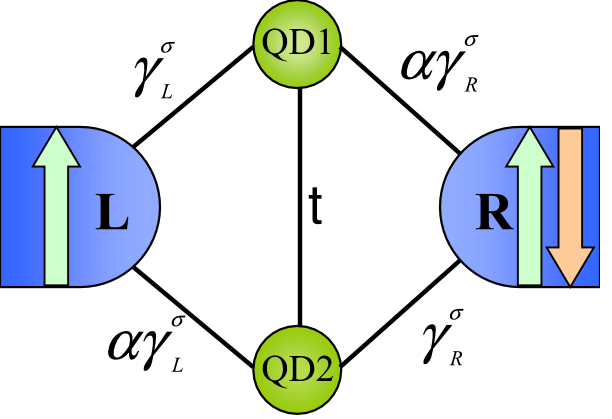
Studies on spin and charge as well as thermal transport properties through various systems of quantum dots coupled to the external leads made of ferromagnets, superconductors, or normal metals are under our main interest. We investigete these systems both in equilibrium and non-equilibrium regimes including time-dependent phenomena. The calculations are made including Kondo effect as well as beyond this limit.
To describe various transport properties we use relevant method. The main theoretical techiques we utilize are: nonequilibrium Green's function approach, numerical renormalization group, slave-boson mean field theory, Haldane's scaling theory, real-time diagrammatic technique, quantum rate equations.
Current-induced Dynamics in Spin Valves
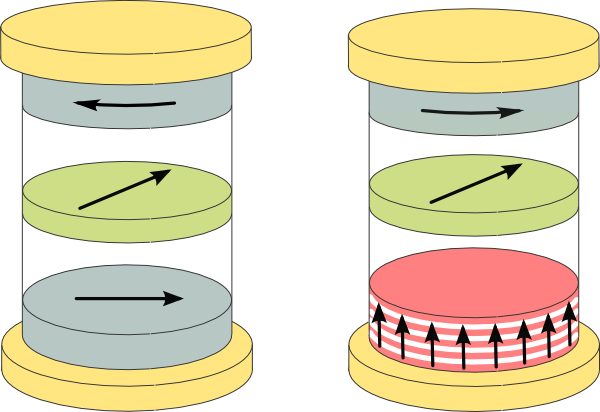
Spin valves are metallic multilayer structures in which magnetic layers are separated by nonmagnetic ones. It has been show that electric resistance of such devices markedly depends on the relative ordering of magnetizations of the magnetic layers. Namely, the resistance is maximum when all the magnetizations are aligned in the same direction and minimum when they are antiparallel. This effect is well known as giant magnetoresistance (GMR). In 2007 its discovery has been awarded by Nobel Prize for A. Fert and P. Grunberg.
Apart from this, the spin polarized current in a spin valve can transfer magnetic momentum between the magnetic layers. Consequently, when the density of passing current is large enough and the magnetization of two adjacent magnetic layers are not collinear, spin torque is acting on the localized magnetic moments. As a result, the magnetization's direction can be reversed by electric current without need of external magnetic field. Additionally, in some spin valves one can induce self-sustained magnetization precessions connected with oscillations of spin valve resistance.
To study these phenomena we employ computer simulations making use of macrospin approximation or micromagnetic models. The spin transfer torque and magnetoresistance is calculated according to a diffusive transport model, which estimates the spin accumulation and spin current in general noncollinear magnetic configurations.
Current-induced Domain Wall Motion
When the electric is passing through a magnetic film with nonhomogeneous magnetic texture, the spin angular momentum is transferred between the noncollinear localized magnetic moments and exerts spin torque varying their direction. This effect leads to motion of magnetic domain walls (DWs) induced by current without a need of external magnetic field. In addition, it has been shown that creation of a DW in a magnetic film leads to variation in the sample's resistance as well. Thus DWs seems to have an ablility to store and transfer information in potential storage devices. In our group, we make use of quantum field methods and semiclassical approaches to study the spin accumulation and spin current as well as current-induced spin transfer torque action on DWs.
Thin Films of Heusler Alloys
In close cooperation with Institute of Molecular Physics (Polish Academy of Sciences) we carry out investigations of thin Heusler alloy films, which are deposited by ultra-high vacuum sputtering. Stress is put on studying magnetization dynamics with the aim to fabricate the films with a low damping of precessional motion, on investigations of exchange bias in Heusler alloy films in contact with antiferromagnets as well as effect of spin pumping in structures comprising half-metallic Heusler alloy films and metallic overlayer with a high inverse spin Hall effect.